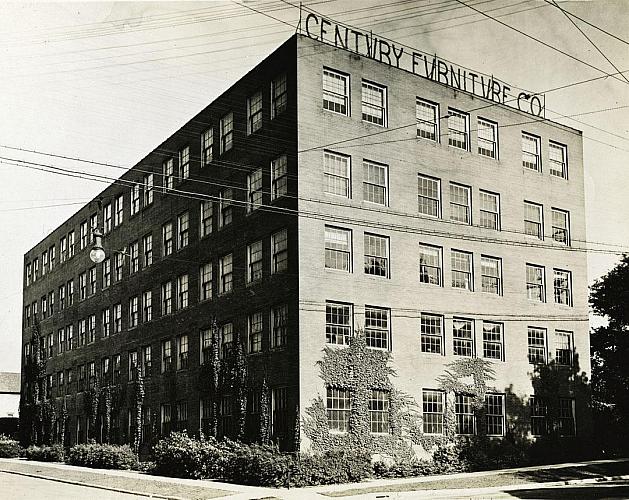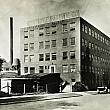Century Furniture Co.
1900 - 1942
Grand Rapids, Michigan
COMPANY HISTORY
1900: Founded by partners David S. Brown and John C. Rickenbaugh.
1905: Incorporated as the Century Furniture Company after the death of Rickenbaugh.
1940: Century purchased by R. J. Murray, President of Murray Furniture Company and designer David L. Evans.
1942: Century declares bankruptcy; a reorganization attempt fails by 1944 due to lack of demand during World War II.
PERSONNEL
Century’s founders were both veterans of the Grand Rapids furniture scene, Brown having worked for Nelson & Matter, and Rickenbaugh having held interests in the Royal Furniture Company. Edgar Somes became an officer in 1906 after leaving his position as designer at Michigan Chair Company. David L. Evans, who participated in the 1940 company buy-out, served as staff designer at Century from 1917 to 1928. His name appears on design drawings in the Museum’s Century Archival Collection.
PRODUCTS
.jpg) Unlike many of the companies started a generation earlier, which began making cheap goods and later upgraded, Century strived from its onset “to manufacture the best possible line of the particular kind of goods many by the company.” Century furniture was well built, with expensive materials and lavish details and decoration. It began primarily as a producer of upholstered goods. Fabrics were rich silks or hand-woven needlework pictorials imported from France.
Unlike many of the companies started a generation earlier, which began making cheap goods and later upgraded, Century strived from its onset “to manufacture the best possible line of the particular kind of goods many by the company.” Century furniture was well built, with expensive materials and lavish details and decoration. It began primarily as a producer of upholstered goods. Fabrics were rich silks or hand-woven needlework pictorials imported from France.
 By the early1930s, it had expended production to include furniture for the living room, dining room, library, hall, bedroom, and office. Case pieces were heavily carved, inlaid with marquetry panels, or painted with elaborate floral and pictorial motives.
By the early1930s, it had expended production to include furniture for the living room, dining room, library, hall, bedroom, and office. Case pieces were heavily carved, inlaid with marquetry panels, or painted with elaborate floral and pictorial motives.
While the company maintained a large line of pieces, only a small number of any single item needed to be produced in a year to keep it in the catalog. Manufacturing followed “batch production,” meaning pieces were not made until enough orders, perhaps twenty-five or fifty, were received to run a “batch.” Each piece could then be custom-finished to order. Records show that some pieces remained active in the catalogue for years, even though no more than a single batch of that piece had been run in an entire year.
 Century was the earliest and perhaps most significant promoter of the antiques reproduction movement in Grand Rapids. A 1911 Grand Rapids herald article credits Edgar Somes with cultivating a collection of antiques for reproduction in the factory. Not satisfied with producing new designs in the manner of historical styles, Century presented their reproductions as “correct” and authentic,” and consequently superior. Lines covered the range of acceptable European and American styles from the Renaissance to the early 19th century. Provenance of originals was often included in ads as a favorable selling point. Pieces were reproduced from such famous locales as Knole House in England, and the Massachusetts “Wayside Inn” immortalized by Longfellow.
Century was the earliest and perhaps most significant promoter of the antiques reproduction movement in Grand Rapids. A 1911 Grand Rapids herald article credits Edgar Somes with cultivating a collection of antiques for reproduction in the factory. Not satisfied with producing new designs in the manner of historical styles, Century presented their reproductions as “correct” and authentic,” and consequently superior. Lines covered the range of acceptable European and American styles from the Renaissance to the early 19th century. Provenance of originals was often included in ads as a favorable selling point. Pieces were reproduced from such famous locales as Knole House in England, and the Massachusetts “Wayside Inn” immortalized by Longfellow.
Century went beyond the exact duplication of historical pieces in their production of new antiques. Many techniques were used in manufacturing to give the finished piece an appearance of great age. Fabrics were woven with threads missing to give the appearance of slight moth damage. Foot rails were planed to simulate centuries of wear. Beautiful woods were beaten with “distressers,” rings of keys, nuts and bolts, to approximate nicks and powder beetle damage. Dark stains were applied around edges and in deep carvings to look like dirt build-up.
OTHER SOURCES
The Grand Rapids Public Museum has a large collection of business records for the Century and Murray Furniture Companies. The Museum has a major collection of Century furniture manufactured from the 1910s through the 1930s. Both the Museum and the Grand Rapids Public Library have significant collections of Century trade catalogs.
MARKS AND LABELS
 Early Century pieces often had square, white paper labels on the underside of a chair seat or table tope, with no logo, but the company name and lines, which sometimes
Early Century pieces often had square, white paper labels on the underside of a chair seat or table tope, with no logo, but the company name and lines, which sometimes.jpg) carry the product number or finish and upholstery information. A number of fanciful monograms were used in advertisements from circa 1905. Some 1910s and 1920s pieces on the Museum’s collection are marked with a pyrotechnic (burn or brand) of the word “Century” with the “u” in a distinctive Roman “v” shape. Most commonly, pieces from the 1910s through the 1920s have a small circular brass tag, which can be found almost any place inconspicuous. The tag bears the logo of a squat Greek cross, with a triangle over the names of the company and city. Beginning around 1928, the company adopted the use of a rectangle with rounded corners, surrounding the words ”CENTURY/GRAND RAPIDS” WITH THE “U” again in the Roman “v” shape.
carry the product number or finish and upholstery information. A number of fanciful monograms were used in advertisements from circa 1905. Some 1910s and 1920s pieces on the Museum’s collection are marked with a pyrotechnic (burn or brand) of the word “Century” with the “u” in a distinctive Roman “v” shape. Most commonly, pieces from the 1910s through the 1920s have a small circular brass tag, which can be found almost any place inconspicuous. The tag bears the logo of a squat Greek cross, with a triangle over the names of the company and city. Beginning around 1928, the company adopted the use of a rectangle with rounded corners, surrounding the words ”CENTURY/GRAND RAPIDS” WITH THE “U” again in the Roman “v” shape.
The source, with permission of the author, is Grand Rapids Furniture: The Story of America’s Furniture City by Christian G. Carron, published by the Grand Rapids Public Museum. 1998.
Transcriber: Rebecca Smith-Hoffman
Full Details
| Title | Century Furniture Co. |
|---|---|
| Address | Grand Rapids, MI |
| Year Opened | 1900 |
| Year Closed | 1942 |
| Location |  |



